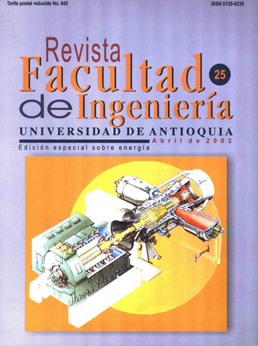Modelo para minimizar el consumo de vapor en un múltiple efecto de evaporación en un ingenio azucarero
DOI:
https://doi.org/10.17533/udea.redin.326348Palabras clave:
Cogeneración, eficiencia energética, programación dinámica, industria azucarera.Resumen
Se muestra en este trabajo un modelo matemático para minimizar los consumos de vapor en un sistema de evaporación de múltiple efecto. La técnica utilizada fue la programación dinámica y los resultados fueron probados en un ingenio azucarero colombiano.Descargas
Citas
Villada, F., "Modelo Económico de Optimización para Cogeneración en un lngenio Cañero", lntemational Sugar Journal, Volume 98. May 1996, London, pp. 265-270.
Bellman, R., "Dynamic Programming", Princeton University Press, Princeton N.J., 1957.
Hugot, E. "Handbook of Sugar Cane Engineering", Elsevier, Amsterdam, 1986.
Murillo, J., "Optimización en la Planeación de Sistemas de Distribución", M.Sc. Thesis. Universidad Tecnológica de Pereira, Colombia, 1992.
Love, D., "'The Use of Dynamic Programming for Determining Optimum Profiles of Operating Conditions in Continuous Pans", Proceedings of the 19th General Assembly of the Commission lntemationale Technique de Sucrerie, Cambridge, 1991, pp. 95-117.
Baloh, T., Witwer E., "Energy Manual for Sugar Factories", Berlín, 1995.
Ley 54/1997 del Sector Eléctrico, BOE No. 285, Madrid, 1997.
Real Decreto 2818/1998 de 23 de diciembre. BOE No. 312, Madrid, 1998.
Ley 697/2001 "Uso Racional de Energía", Diario Oficial 44.573, Bogotá, 2001.
Descargas
Publicado
Cómo citar
Número
Sección
Licencia
Los artículos disponibles en la Revista Facultad de Ingeniería, Universidad de Antioquia están bajo la licencia Creative Commons Attribution BY-NC-SA 4.0.
Eres libre de:
Compartir — copiar y redistribuir el material en cualquier medio o formato
Adaptar : remezclar, transformar y construir sobre el material.
Bajo los siguientes términos:
Reconocimiento : debe otorgar el crédito correspondiente , proporcionar un enlace a la licencia e indicar si se realizaron cambios . Puede hacerlo de cualquier manera razonable, pero no de ninguna manera que sugiera que el licenciante lo respalda a usted o su uso.
No comercial : no puede utilizar el material con fines comerciales .
Compartir igual : si remezcla, transforma o construye a partir del material, debe distribuir sus contribuciones bajo la misma licencia que el original.
El material publicado por la revista puede ser distribuido, copiado y exhibido por terceros si se dan los respectivos créditos a la revista, sin ningún costo. No se puede obtener ningún beneficio comercial y las obras derivadas tienen que estar bajo los mismos términos de licencia que el trabajo original.










 Twitter
Twitter